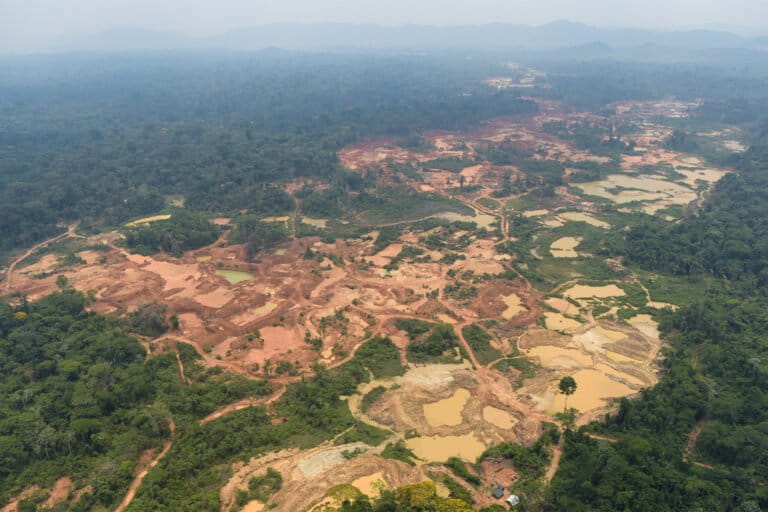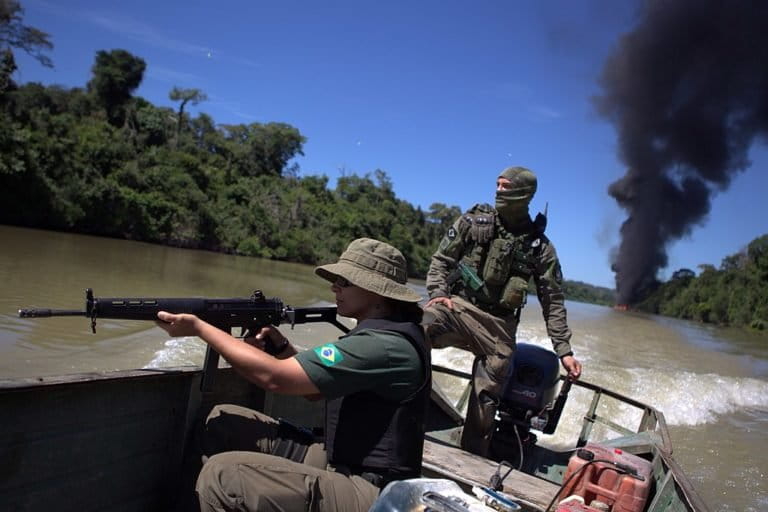- Global biodiversity hotspots, which cover only 2.4% of the Earth’s land, have witnessed more than 80% of armed conflicts between 1950 and 2000, some of which continue even today.
- Armed conflicts, driven by various factors, result in big losses for biodiversity and impact Indigenous ways of life.
- A new study finds four-fifths of these armed conflicts in biodiversity hotspots occur on Indigenous peoples’ lands — yet these areas remain in better shape ecologically than conflict-affected non-Indigenous lands.
- The study underlines the role Indigenous peoples play in environmental conservation, and highlights Indigenous self-determination as key to conservation and prevention of armed conflicts.
For nearly 2,000 years, the Indigenous Karen people of southeast Myanmar have led a relatively tranquil life in the hilly forests that are part of the Indo-Burma biodiversity hotspot. But in the last seven decades, Karen civilians have found themselves entangled in the world’s longest armed conflict, between the Karen National Union and the Myanmar military regime—a battle over self-determination that’s been a part of the wider Myanmar civil war.
For them, the forests their ancestors once stewarded are also shelter to retreat to as they flee from the repeated deadly airstrikes by the military regime on their villages, schools and hospitals.
“It’s because they’ve been protecting the forest and maintaining biodiversity that they have these safe places to escape to whenever the Burmese army have come in the past,” says Casper Palmano, program adviser at the nonprofit Karen Environmental and Social Action Network (KESAN), based in neighboring Thailand.
Armed conflicts in a biodiversity hotspot, like those faced by the Karen people, aren’t just a problem in Myanmar, the country formerly known as Burma. Between 1950 and 2000, nine out of 10 major armed conflicts have occurred in countries with areas brimming with biodiversity. More than 80% of these conflicts in the hotspots have led to wide-scale biodiversity loss, deforestation and other environmental impacts.

And in the last 70 years, a disproportionately higher number of such armed conflicts, about four-fifths, have also occurred on Indigenous peoples’ lands inside a biodiversity hotspot, according to a recent study published in the journal Biological Conservation. Indigenous peoples face indiscriminate killings, forced displacement and cultural breakdown as their societies and economies irrevocably change.
Despite the conflicts, these lands faced less environmental damage and fewer human impacts than other lands subject to the same external pressures but not designated as Indigenous lands.
The study found that a quarter, 25%, of areas on conflict-affected Indigenous lands within biodiversity hotspots were “natural lands” — areas not modified by humans and likely to support biodiversity. In comparison, only 10% of other lands facing armed conflicts were “natural lands.”
Conflict-affected Indigenous lands also registered a smaller human footprint compared to other conflict-affected lands in biodiversity hotspots. The study attributes this to the centuries-old relationship Indigenous communities have had with their lands, like the Karen people of Myanmar, and their difficult terrain.
“We knew that biodiversity and environmental conditions were better on Indigenous peoples’ lands, but the fact that we actually got this result for so many different conflict situations was a real surprise for me,” corresponding author Stephen Garnett, from Charles Darwin University, Australia, told Mongabay.
Drivers of armed conflicts
As many of the last remaining pockets of unexploited resources on the planet, Indigenous peoples’ lands have become increasingly targeted in recent years for exploitation and development.
“Those are areas where people have a very caring relationship with their environment, and for that very reason, that environment remains unspoiled to some extent,” says Nikita Bulanin from the nonprofit International Work Group for Indigenous Affairs (IWGIA), who was not affiliated with the study.
There are lots of economic interests around these Indigenous lands, because in other areas, the resources have been exploited to some extent that there is nothing left, he tells Mongabay.

The study revealed that 31 of the 36 recognized global biodiversity hotspots included Indigenous lands. Among them, 79% have experienced armed conflicts in recent decades. In contrast, only half of other lands within biodiversity hotspots saw armed conflicts.
In Myanmar’s Kayin state, home of the Karen people, their resource-rich territories are at the heart of the conflicts. These lands hold mineral resources like gold, the world’s best teak forests, and rivers suited for hydroelectric dam projects. “Powerful politicians and [the] army want to control the territory and exploit and make money,” says Paul Sein Twa, co-founder and executive director of KESAN. “We are squeezed in between.”
Myanmar’s departments of defense and environment did not respond to Mongabay’s requests for a comment by the time of publication.
In some Indigenous communities, poverty drives people into the “gray,” or informal, economy, where they become entangled in further conflicts, or overexploit resources that they once cared for. This can lead to conflicts within and among Indigenous communities. In many cases, governments force people off their lands as part of conservation plans or to extend their territorial control, leading to heightened tensions.
And when armed conflict flares up in any type of area, there is tremendous collateral damage, including to the surrounding environment, says David Berger, an adviser at the IWGIA.
To conduct the study, the researchers analyzed spatial data of Indigenous lands, biodiversity hotspots and 265 armed conflicts that took place since the 1940s across South Asia, South America, Africa, Southern Europe and the Middle East, and looked for regions that intersect. Then they estimated the environmental quality of these intersected lands by measuring the human impacts observed in them — such as the construction of roads, railways and waterways, croplands and pastoral lands, the built environment, economic activities, and artificial light pollution.
They then calculated that Indigenous lands within biodiversity hotspots affected by conflict had more than double the percentage of natural lands compared to other lands.
“This demonstrates the importance of recognizing Indigenous land rights, including in some of the most difficult contexts such as armed conflicts,” says Philippe LeBillon from the University of British Columbia, Canada, who studies political ecology and wars and was not affiliated with the current study.


Although the study paints a global picture of how armed conflicts affect Indigenous lands in biodiversity hotspots, recent data for some of the regions studied were not available. “But the general picture [from the study] we think is reasonable,” Garnett says.
The findings resonate with experiences on the ground, Berger says. But he adds he’s unsure if the IWGIA can corroborate it with the data it has available, and says the research community should work toward updating such vital data sets and measurements.
Supporting peace in biodiverse conflict zones
Stopping armed conflicts would be the first step toward helping biodiversity conservation in the affected areas, and would be a complex feat. But Indigenous self-determination and participation in extractive projects could go a long way to sustaining peace in conflict zones. Collaborating on conservation projects, instead of evicting communities or ceasing their livelihoods, would also address root causes of conflicts.
“We should be looking to Indigenous partners to really lead and direct and be the ones who are guiding us in conservation work rather than the other way around,” says study co-author Madeline Beattie from Conservation International.
When Indigenous peoples are left alone, they can solve issues creatively, says Bulanin from the IWGIA, citing the case of the award-winning Salween Peace Park in Myanmar. The park, established by local organizations including KESAN in 2018, spans 5,485 square kilometers (2,118 square miles) and aims to spearhead peace, conservation and a model of self-determination in the region. However, the park itself has recently been dragged into conflict in Myanmar’s ongoing civil war.
When an armed conflict has for the most part subsided, a peace plan is also needed to conserve the biodiversity hotspot, say the authors of the study.
Post-conflict periods often see greater environmental degradation as the onset of relative peace opens up more lands and attracts investments into extractive activities. It then becomes even more crucial to reinforce Indigenous rights and protect environmental defenders, LeBillon tells Mongabay in an email.
“If the world thinks that the work that we do is really important for the whole world,” says Twa from KESAN, “I think that they should stop destroying the last lives that are found in our territories, and they should really find ways to support us even in armed conflict.”
Banner image: Leader Vanda Ortega, of the indigenous Witoto people, in a forest area in the western zone of Manaus, Amazonas, Brazil. Image by IMF Photo/Raphael Alves via Flickr (CC BY-NC-ND 2.0).
Award-winning, Indigenous peace park dragged into fierce conflict in Myanmar
Citation:
Beattie, M., Fa, J. E., Leiper, I., Fernández-Llamazares, Á., Zander, K. K., & Garnett, S. T. (2023). Even after armed conflict, the environmental quality of Indigenous Peoples’ lands in biodiversity hotspots surpasses that of non-Indigenous lands. Biological Conservation, 286, 110288. doi:10.1016/j.biocon.2023.110288
FEEDBACK: Use this form to send a message to the author of this post. If you want to post a public comment, you can do that at the bottom of the page.
